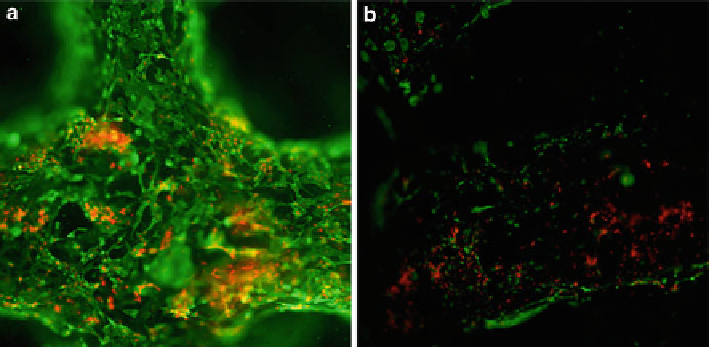Biomedical Engineering Reference
In-Depth Information
Fig. 9.12
ADC cells, cultured with EGF, in a 3D gelatin/alginate(/fibrin) scaffold to differentiate
into endothelial cells and adipocytes. (
a
,
b
) Immunostaining with mAbs for mature endothelial
cells in
green
and PI for nuclear in
red
. (
a
) ADC cells within a gelatin/alginate/fibrin construct, and
(
b
) without fibrin. The pictures were reprinted from [
194
] with permission from Elsevier
multicellular construct in order to fabricate tubular constructs (Fig.
9.11
) [
287
] .
Agarose, being an inert and biocompatible hydrogel, is not remodelled by the
cells and can easily be removed after fusion of the bio-ink. In situ crosslinkable
synthetic ECM (sECM) mimetic hydrogels formed by co-crosslinking PEG-
diacrylate and modified hyaluronic acid (HA)/gelatin to the corresponding thio-
lated dithiopropionylhydrazide (DTPH) derivatives were developed as bio-paper
by Mironov et al. [
293
]. Other examples of hydrogels that served as bio-paper
include fibrin, Matrigel™, fibrinogen, PNIPAM and polyethylene glycol tetra-
acrylates [
229,
235,
279,
288
] .
It is somewhat unclear as to whether the fabrication of cell/gel hybrid constructs,
which has already been brought up in the previous part, falls under the category of
bioprinting or if it can be regarded, as it is our understanding, as a bridge between
pure scaffold-based and pure scaffold-free TE strategies. For instance, Skardal et al.
[
195
] methacrylated HA and gelatin, in order to fabricate tubular photocrosslink-
able constructs from partially pre-crosslinked hydrogels and cells suspended within.
The importance that is correlated to the biomaterial(s) used, as is clarified in
Fig.
9.12
, notes the primary distinction with pure scaffold-free TE. Xu and col-
leagues made 3D cell/gel hybrid scaffolds from ADS cells and gelatin/alginate/fibrin
hydrogels to model the metabolic syndrome (MS) in 3D [
194
] . Their work revealed
the potential use of this 3D physiological model for drug discovery and the use of
fibrin as an effective material to regulate ADC cell differentiation and self-organi-
zation into adipocytes and endothelial cells. Nevertheless the importance appointed
to the biomaterial, cells are being encapsulated within the structure, and therefore
this approach deflects somewhat from pure scaffold-based engineering. Maybe the
future shows that this state-of-the-art TE concept and cross-over approach of the
two main distinct TE premises leads to some fascinating results and research.

Search WWH ::

Custom Search